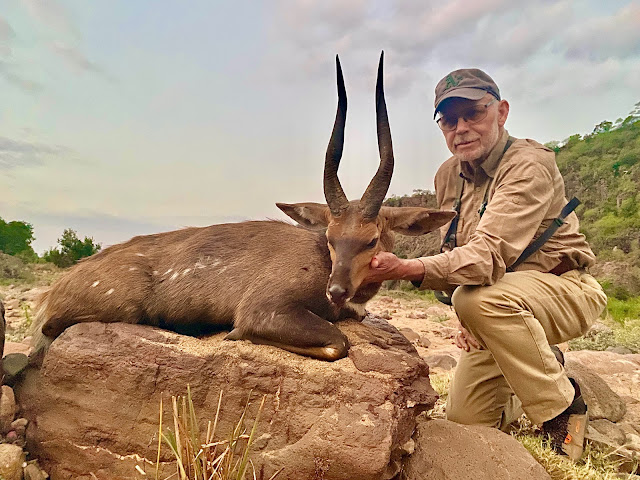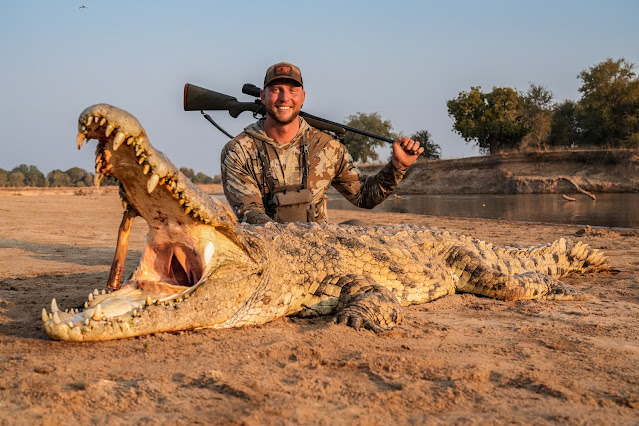Part 4 is going to be lacking some pictorial support. My I Phone which contained all but a few of the inletting, shaping and sanding pics went to the bottom of the Tallulah river in Northern GA.
Stock Fit, where to start? How many times have you heard the phrase " I want my DGR's to fit and point like a fine bird gun". Not me thank you.
Let me be 1st to admit that you can use almost any commercially made rifle to hunt dangerous game, admittedly some handle better than others for this application. The Pre-64 Winchester Model 70 375's and 458's are great examples if you can use the average LOP of 13-1/2" to 13-5/8 " and are Right Handed. The straight comb height on the older versions allowed most hunters to acquire the factory iron sights very well. The later Monte Carlo Version worked out equally well with a low mounted scope from that era such as the 2.5X to 3X and the later 1.5x20 Leupold.
Like a good suit you can tailor fit an iron sight rifle stock with the proper comb height to allow you to acquire the line of sight without having to cram your head into the side of the butt and down onto the comb. Usually the iron sights I fabricate are approximately 1.000 above the centerline of the bore.
Put a scope on that same rifle and most people will still be able to shoot it effectively even while having to very slightly raise their face off the comb to get the full field of view in the scope which is now mounted so the optical line of sight is 1.5" above the centerline of the bore.
Conversely if you build a stock with just enough clearance at the nose of comb for the cocking piece to clear and continue that same comb height rearward to the heel and then try to use most iron sights mounted low on the barrel and your likely to have issues even seeing the sights using that comb height. Again your milage might vary as everybody is different.
Again, this stock was to be tailor fit to a left-handed client with a bent trigger finger.
LB walked into the shop early on a Fall morning and we went to work. With the pattern stock and complete barreled action bolted together we began the final refining the fit of the butt stock with the LB lifting and pointing the muzzle at nearby objects, at the ground, into the sky and more importantly directly at my right eye many, many times. LB being an experienced rifle and shotgun hand was no novice to this and other past fitting sessions.
There were no misconceptions about trying to give this rifle the dynamics of 28 gauge quail gun, a Clays gun or for that matter a typical hunting rifle. The goal was to allow the rifle be brought to bare quickly, giving the rifle a comfortable balance and point ability allowing LB to direct a single bullet accurately on demand from 5 to 100 yards and operated the bolt at speed for rapid follow up shots if required.
A properly designed an iron sight rifle stock to some degree becomes the rear sight similar to a shotgun stock. Hence the attention to LB's required length of pull, cast on at the heel and toe, pitch angle, and the comb height at the face position on the butt when the rifle was mounted quickly or casually. My end goal was the have the front ramp pointing vertically at 12 Clock and have LB's left eye looking as straight down the barrel when viewed from the muzzle end.
The objective was to give the rifle balance the dynamics for the execution of an accurate shot, controlling the recoil as best as possible, allowing recoil recovery for a follow up shot or three if the situation required it.
Having built quite a number of heavy rifles over my career I already had a good idea of where these dimensions were headed but as stated before, I am not left handed, You can always guess or you can fit.
LB happy with the final results and headed off on a deer hunt.
Then the French walnut stock was final inlet and final shaped per the specs we'd come up with. Despite some moaning in the back-ground in regard to using a pattern stock and a pantograph, the metal still must properly be fit by hand.




At this point you'll have to use your imagination as the pic history remember is "swimming with the fishes".
With the final shaping complete the sanding process began. Then the cross bolts, recoil pad and rear swivel base were installed followed by sealer and the 1st coats of finish. The Wells trigger was now attached to the underside of the receiver again.
The rifle was now ready to actually shoot, except for one small set back.
Up to this point the rifle had never been dry fired, there was no need. The safety wing and striker cam angle wasn't established or timed and didn't really need to be to test fire the rifle. I assembled the bolt sleeve, main spring and cocking piece group together, screwed into the back of the bolt body and cocked the 450 for the 1st time. I then squeezed the trigger to get an idea of what the trigger weight of pull might be like right out of the box. After I doing this procedure about 4 times I noticed that opening the bolt became considerably more difficult every time I dry fired the rifle, what the .........................
I unscrewed the bolt sleeve and pin assembly and removed it from the bolt body and immediately noticed the nose of the firing was bent. Not again !!!!
I was once again the owner of a bolt body that had a firing pin hole drilled off center into the bolt face.
With a slip fit gauge pin inserted into the firing pin hole the issue is easy clearly evident
Believe it or not this is the 2nd time I have had a similar bolt in my shop. The 1st being a Hartmann and Weiss magnum Mauser bolt suffering from the very same anomaly, lucky me. Rather than return the entire bolt to Germany as requested by H&W I sought out a master of what I knew was now required.
I made a call to Greg Tannel owner and operator of Gre-Tan Rifles LLC and explained my dilemma. I described the issue to Greg he chuckled and replied " no problem, send it over ". I straightened the firing pin tip in the lathe with a brass drift and an indicator then placed both the pin and the bolt body in a box and sent it to Greg and had him bush the bolt face, one of his many talents. In short order the surgically repaired bolt returned and I was finally ready for some range time.









































.jpeg)











.jpeg)

